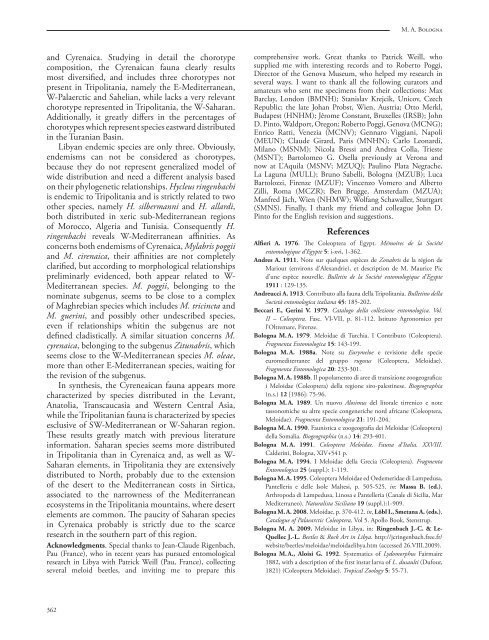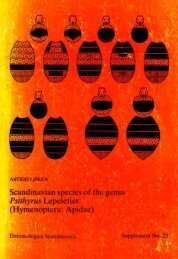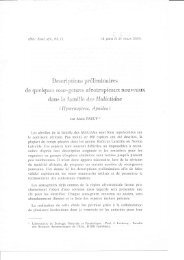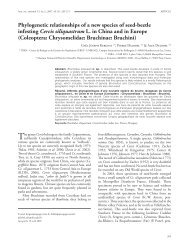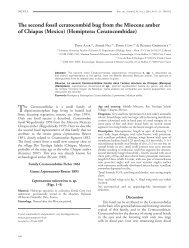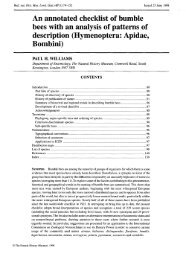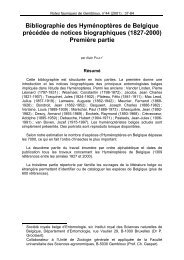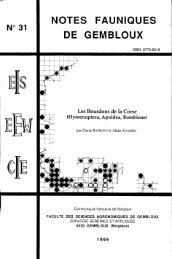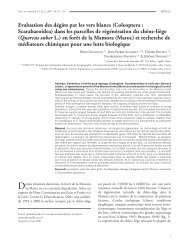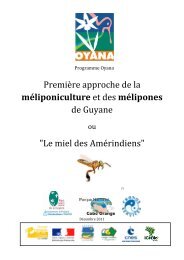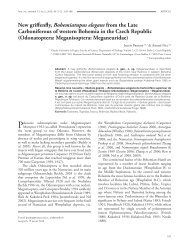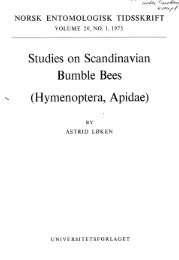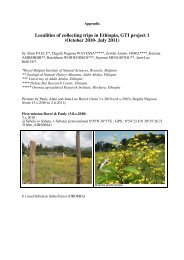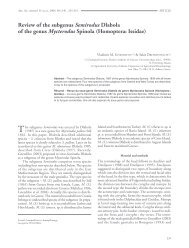Bologna 2009 - Beetles and Rock Art in Libya - Free
Bologna 2009 - Beetles and Rock Art in Libya - Free
Bologna 2009 - Beetles and Rock Art in Libya - Free
You also want an ePaper? Increase the reach of your titles
YUMPU automatically turns print PDFs into web optimized ePapers that Google loves.
M. A. <strong>Bologna</strong><br />
<strong>and</strong> Cyrenaica. Study<strong>in</strong>g <strong>in</strong> detail the chorotype<br />
composition, the Cyrenaican fauna clearly results<br />
most diversified, <strong>and</strong> <strong>in</strong>cludes three chorotypes not<br />
present <strong>in</strong> Tripolitania, namely the E-Mediterranean,<br />
W-Palaerctic <strong>and</strong> Sahelian, while lacks a very relevant<br />
chorotype represented <strong>in</strong> Tripolitania, the W-Saharan.<br />
Additionally, it greatly differs <strong>in</strong> the percentages of<br />
chorotypes which represent species eastward distributed<br />
<strong>in</strong> the Turanian Bas<strong>in</strong>.<br />
<strong>Libya</strong>n endemic species are only three. Obviously,<br />
endemisms can not be considered as chorotypes,<br />
because they do not represent generalized model of<br />
wide distribution <strong>and</strong> need a different analysis based<br />
on their phylogenetic relationships. Hycleus r<strong>in</strong>genbachi<br />
is endemic to Tripolitania <strong>and</strong> is strictly related to two<br />
other species, namely H. silbermanni <strong>and</strong> H. allardi,<br />
both distributed <strong>in</strong> xeric sub-Mediterranean regions<br />
of Morocco, Algeria <strong>and</strong> Tunisia. Consequently H.<br />
r<strong>in</strong>genbachi reveals W-Mediterranean aff<strong>in</strong>ities. As<br />
concerns both endemisms of Cyrenaica, Mylabris poggii<br />
<strong>and</strong> M. cirenaica, their aff<strong>in</strong>ities are not completely<br />
clarified, but accord<strong>in</strong>g to morphological relationships<br />
prelim<strong>in</strong>arly evidenced, both appear related to W-<br />
Mediterranean species. M. poggii, belong<strong>in</strong>g to the<br />
nom<strong>in</strong>ate subgenus, seems to be close to a complex<br />
of Maghrebian species which <strong>in</strong>cludes M. tric<strong>in</strong>cta <strong>and</strong><br />
M. guer<strong>in</strong>i, <strong>and</strong> possibly other undescribed species,<br />
even if relationships whit<strong>in</strong> the subgenus are not<br />
def<strong>in</strong>ed cladistically. A similar situation concerns M.<br />
cyrenaica, belong<strong>in</strong>g to the subgenus Zitunabris, which<br />
seems close to the W-Mediterranean species M. oleae,<br />
more than other E-Mediterranean species, wait<strong>in</strong>g for<br />
the revision of the subgenus.<br />
In synthesis, the Cyreneaican fauna appears more<br />
characterized by species distributed <strong>in</strong> the Levant,<br />
Anatolia, Transcaucasia <strong>and</strong> Western Central Asia,<br />
while the Tripolitanian fauna is characterized by species<br />
esclusive of SW-Mediterranean or W-Saharan region.<br />
These results greatly match with previous literature<br />
<strong>in</strong>formation. Saharan species seems more distributed<br />
<strong>in</strong> Tripolitania than <strong>in</strong> Cyrenaica <strong>and</strong>, as well as W-<br />
Saharan elements, <strong>in</strong> Tripolitania they are extensively<br />
distributed to North, probably due to the extension<br />
of the desert to the Mediterranean costs <strong>in</strong> Sirtica,<br />
associated to the narrowness of the Mediterranean<br />
ecosystems <strong>in</strong> the Tripolitania mounta<strong>in</strong>s, where desert<br />
elements are common. The paucity of Saharan species<br />
<strong>in</strong> Cyrenaica probably is strictly due to the scarce<br />
research <strong>in</strong> the southern part of this region.<br />
Acknowledgments. Special thanks to Jean-Claude Rigenbach,<br />
Pau (France), who <strong>in</strong> recent years has pursued entomological<br />
research <strong>in</strong> <strong>Libya</strong> with Patrick Weill (Pau, France), collect<strong>in</strong>g<br />
several meloid beetles, <strong>and</strong> <strong>in</strong>vit<strong>in</strong>g me to prepare this<br />
comprehensive work. Great thanks to Patrick Weill, who<br />
supplied me with <strong>in</strong>terest<strong>in</strong>g records <strong>and</strong> to Roberto Poggi,<br />
Director of the Genova Museum, who helped my research <strong>in</strong><br />
several ways. I want to thank all the follow<strong>in</strong>g curators <strong>and</strong><br />
amateurs who sent me specimens from their collections: Max<br />
Barclay, London (BMNH); Stanislav Krejcik, Unicov, Czech<br />
Republic; the late Johan Probst, Wien, Austria; Otto Merkl,<br />
Budapest (HNHM); Jêrome Constant, Bruxelles (IRSB); John<br />
D. P<strong>in</strong>to, Waldport, Oregon; Roberto Poggi, Genova (MCNG);<br />
Enrico Ratti, Venezia (MCNV); Gennaro Viggiani, Napoli<br />
(MEUN); Claude Girard, Paris (MNHN); Carlo Leonardi,<br />
Milano (MSNM); Nicola Bressi <strong>and</strong> Andrea Colla, Trieste<br />
(MSNT); Bartolomeo G. Osella previously at Verona <strong>and</strong><br />
now at L’Aquila (MSNV; MZUQ); Paul<strong>in</strong>o Plata Negrache,<br />
La Laguna (MULL); Bruno Sabelli, <strong>Bologna</strong> (MZUB); Luca<br />
Bartolozzi, Firenze (MZUF); V<strong>in</strong>cenzo Vomero <strong>and</strong> Alberto<br />
Zilli, Roma (MCZR); Ben Brugge, Amsterdam (MZUA);<br />
Manfred Jäch, Wien (NHMW); Wolfang Schawaller, Stuttgart<br />
(SMNS). F<strong>in</strong>ally, I thank my friend <strong>and</strong> colleague John D.<br />
P<strong>in</strong>to for the English revision <strong>and</strong> suggestions.<br />
References<br />
Alfieri A. 1976. The Coleoptera of Egypt. Mémoires de la Société<br />
entomologique d’Egypte 5: i-xvi, 1-362.<br />
Andres A. 1911. Note sur quelques espèces de Zonabris de la région de<br />
Mariout (environs d’Alex<strong>and</strong>rie), et description de M. Maurice Pic<br />
d’une espèce nouvelle. Bullet<strong>in</strong> de la Société entomologique d’Egypte<br />
1911 : 129-135.<br />
Andreucci A. 1913. Contributo alla fauna della Tripolitania. Bullet<strong>in</strong>o della<br />
Società entomologica italiana 45: 185-202.<br />
Beccari F., Ger<strong>in</strong>i V. 1979. Catalogo della collezione entomologica. Vol.<br />
II – Coleoptera. Fasc. VI-VII, p. 81-112. Istituto Agronomico per<br />
l’Oltremare, Firenze.<br />
<strong>Bologna</strong> M. A. 1979. Meloidae di Turchia. I Contributo (Coleoptera).<br />
Fragmenta Entomologica 15: 143-199.<br />
<strong>Bologna</strong> M. A. 1988a. Note su Eurymeloe e revisione delle specie<br />
euromediterranee del gruppo rugosus (Coleoptera, Meloidae).<br />
Fragmenta Entomologica 20: 233-301.<br />
<strong>Bologna</strong> M. A. 1988b. Il popolamento di aree di transizione zoogeografica:<br />
i Meloidae (Coleoptera) della regione siro-palest<strong>in</strong>ese. Biogeographia<br />
(n.s.) 12 [1986]: 75-96.<br />
<strong>Bologna</strong> M. A. 1989. Un nuovo Alosimus del litorale tirrenico e note<br />
tassonomiche su altre specie congeneriche nord africane (Coleoptera,<br />
Meloidae). Fragmenta Entomologica 21: 191-204.<br />
<strong>Bologna</strong> M. A. 1990. Faunistica e zoogeografia dei Meloidae (Coleoptera)<br />
della Somalia. Biogeographia (n.s.) 14: 293-401.<br />
<strong>Bologna</strong> M. A. 1991. Coleoptera Meloidae. Fauna d‘Italia. XXVIII.<br />
Calder<strong>in</strong>i, <strong>Bologna</strong>, XIV+541 p.<br />
<strong>Bologna</strong> M. A. 1994. I Meloidae della Grecia (Coleoptera). Fragmenta<br />
Entomologica 25 (suppl.): 1-119.<br />
<strong>Bologna</strong> M. A. 1995. Coleoptera Meloidae ed Oedemeridae di Lampedusa,<br />
Pantelleria e delle Isole Maltesi, p. 505-525. <strong>in</strong>: Massa B. (ed.),<br />
<strong>Art</strong>hropoda di Lampedusa, L<strong>in</strong>osa e Pantelleria (Canale di Sicilia, Mar<br />
Mediterraneo). Naturalista Siciliano 19 (suppl.):1-909.<br />
<strong>Bologna</strong> M. A. 2008. Meloidae, p. 370-412. <strong>in</strong>, Löbl I., Smetana A. (eds.),<br />
Catalogue of Palaearctic Coleoptera, Vol 5. Apollo Book, Stenstrup.<br />
<strong>Bologna</strong> M. A. <strong>2009</strong>. Meloidae <strong>in</strong> <strong>Libya</strong>, <strong>in</strong>: R<strong>in</strong>genbach J.-C. & Le-<br />
Quellec J.-L. <strong>Beetles</strong> & <strong>Rock</strong> <strong>Art</strong> <strong>in</strong> <strong>Libya</strong>. http://jcr<strong>in</strong>genbach.free.fr/<br />
website/beetles/meloidae/meloidaelibya.htm (accessed 26.VIII.<strong>2009</strong>).<br />
<strong>Bologna</strong> M. A., Aloisi G. 1992. Systematics of Lydomorphus Fairmaire<br />
1882, with a description of the first <strong>in</strong>star larva of L. dusaulti (Dufour,<br />
1821) (Coleoptera Meloidae). Tropical Zoology 5: 55-71.<br />
362


